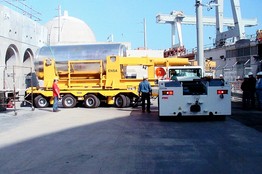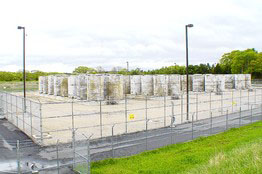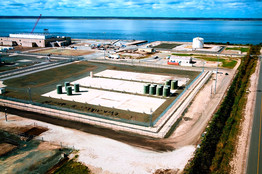Atomic Waste Gets ‘Temporary’ Home
6/2/10
By REBECCA SMITH
Wall Street Journal
Three months after the U.S. cancelled a plan to build a vast nuclear- waste repository in Nevada, the country’s ad hoc atomic-storage policy is becoming clear in places like Wiscasset, Maine.
Wiscasset doesn’t even have a nuclear-energy plant anymore. The Maine Yankee facility was shuttered back in 1996 after developing problems too costly to fix, and the reactor was dismantled early this decade. What’s left is a bare field of 167 acres cleared and ready for development—except for one thing.
Left behind are 64 enormous steel-and-concrete casks that hold 542 metric tons of radioactive waste. Seventeen feet tall and 150 tons apiece, the casks are protected by razor wire, cameras and a security force.

Spent nuclear fuel being stored at the San Onofre plant in San Clemente, Calif.
Southern California Edison
Casks like these are the power industry’s biggest hot potatoes. Their presence at a defunct reactor site like Wiscasset’s underscores the intractability of the nuclear-waste problem confronting the power sector and the failure of U.S. policymakers to find a permanent solution. Meant for temporary storage next to energy plants, these containers are now serving as de facto indefinite repositories around America.
The Energy Department has been legally obligated to relieve nuclear plants of radioactive spent fuel since February 1998, but hasn’t lived up to that requirement, because, quite simply, the government hasn’t found a permanent place to put it.
Any hope of an end to this impasse evaporated in March when the Energy Department notified the federal Atomic Safety and Licensing Board that it wanted to drop plans for a federal repository at Yucca Mountain, Nev.
That meant that after three decades and more than $10 billion in expenditures, the Energy Department was giving up on its only candidate for permanent storage.
The department said it was time for a complete reassessment of the waste problem, and Energy Secretary Steven Chu pointed out that Yucca Mountain wasn’t big enough to meet current and future needs.
Stephanie Mueller, Department of Energy spokeswoman, said in April that nuclear energy has "an important role to play…to cut carbon pol lution and create new clean-energy jobs." She says the president and the energy secretary are looking to a new blue ribbon commission to recommend "a safe, long-term solution" to the waste problem within 18 months.
Instead of moving waste to a geologic vault, such as a mountain enclosure like Yucca capable of locking it away for thousands of years, the foreseeable future now belongs to temporary holding vessels such as the steel-and-concrete casks at Maine Yankee. Each is licensed to contain waste for 20 years.
Power companies are likely to rely on casks even more in coming years. About 80% of reactor sites in the U.S. intend to move used fuel to casks because their storage pools are filling up.
In New Jersey, Public Service Enterprise Group Inc. has built dry storage in Lower Alloways Creek. The utility this week started filling four casks there with waste from its power plant in Hope Creek; in September, the Lower Alloways site will begin receiving waste from a nearby Salem plant. PSEG wants enough storage "to last us 60 years," says Joe Delmar, a spokesman.

Maine Yankee Atomic Power Co.
Wiscasset, Maine.
Utilities have filed more than 70 lawsuits against the government accusing it of breach of contract because it hasn’t taken the waste. So far, $1.3 billion has been paid out. The Department of Justice estimates the liability will top $12 billion if a waste facility is not opened by 2020.
The current state of affairs "does not bolster the credibility of our government to handle this matter competently," says Dale Klein, a former Republican chairman of the federal Nuclear Regulatory Commission.
Meanwhile, utilities continue to contribute $770 million a year to a Nuclear Waste Fund to pay for a permanent repository that now isn’t even on the drawing board.
In April, a group of utilities sued the federal government, demanding that these storage fees be suspended. Ellen Ginsberg, general counsel of the Nuclear Energy Institute, a trade group, says, "We don’t want to pay any more fees until the government has a waste plan."
So far, more than 800 casks have been filled and they sit tucked away behind fences on reactor sites. They hold 14,000 metric tons of waste, an amount that is steadily growing. There is an additional 49,000 metric tons being held in spent-fuel pools, used fuel’s first stop after it leaves reactors. Each year, another 2,000 metric tons of nuclear reactor waste is created.
This waste mostly consists of fuel rods that are used to make the heat that’s converted into electricity in nuclear power plants. It’s highly radioactive and must be handled carefully by robotic machines when it isn’t stored in special radiation-blocking containers.

PSEG Nuclear
Lower Alloways Creek, N.J.
When fuel is removed from the reactor core, it’s stored in pools for several years to allow it to become cooler and slightly less radioactive. After five years or so, it’s able to be moved to dry casks that are filled with inert gas. Sensors keep track of their temperature and watch for radioactive leaks.
But casks, originally intended for transporting waste and not permanently storing it, aren’t an ideal solution, say industry experts and advocacy groups. One major concern is the adequacy of security to protect them from potential attacks.
"For most people, it’s out of sight, out of mind," says Ray Shadis, spokesman for the New England Coalition. His group fears casks could become terrorism targets. The group is calling for security changes at reactor sites, including burying casks or camouflaging them so they aren’t "open to line-of-sight targeting by anyone with a shoulder-mounted rocket," says Mr. Shadis.
The NRC says these worries are overblown but, as it doesn’t disclose security plans, it’s hard for outsiders to assess the adequacy. Casks "are very robust containers," says Raymond Lorson, deputy director of the NRC’s Division of Spent Fuel and Transportation.
Nevertheless, if spent fuel were to hit the atmosphere, it would pose a risk for anyone exposed to the radiation. Depending on the dose, it could result in injury or death, scientists say.
Used fuel is placed in helium-filled containers with two- to five- inch thick steel walls, welded shut. Those canisters are then wrapped in two feet or more of steel-reinforced concrete. Mr. Lorson says the NRC has conducted studies of "severe events"—which he won’t describe—and judged the casks hardy.
Cask makers say their products can withstand a direct hit from a commercial jet, so long as they aren’t hit by landing gear. The rest of the plane crumples on impact.
Even so, some utilities have taken steps to address safety. Entergy Corp., the owner of several nuclear plants, has erected an earthen mound to block visibility of its storage area at its Vermont Yankee plant.
Meanwhile, officials are considering extending the working lives of casks.
Nobody really knows how long casks can keep radioactive waste safely isolated, but casks are licensed for 20 years. The U.S. Nuclear Regulatory Commission now is considering upping the basic license to 40 years and allowing a 20-year extension. Fearing that 60 years may not be enough, the NRC recently asked staff to think about how utilities could manage waste safely for up to 120 years.
It would have been impossible to predict, 20 years ago, that dry casks would become so important.
In the 1960s, when the first commercial reactors were built, spent fuel pools were small because plant operators thought the federal government soon would relieve utilities of waste. A reprocessing plant that was to have taken used fuel and turned it back into useful fuel opened up in West Valley, N.Y., in 1966.
Then India conducted a nuclear weapons test in 1974, and reprocessing fell out of favor due to fears it could produce weapons- grade plutonium that might fall into dangerous hands.
In 1982, Congress passed the Nuclear Waste Policy Act which proposed the creation of two waste repositories, one in the eastern part of the U.S. and one in the west. The energy department looked at nine sites before culling the list to three, all in the west, a few years later.
By the mid 1980s, utilities started to store waste in casks while they waited for a federal solution.
Yet, by the end of the decade, the political situation had changed and the energy department was focused exclusively on sparsely populated Nevada for a waste repository.
The decision "eliminated a lot of the political opposition" elsewhere, says Mark Holt, a researcher for the Congressional Research Service.
With a storage solution approaching, utilities began paying money into a fund that was expected to cover transportation and storage costs.
Not surprisingly, opposition to Yucca Mountain erupted in Nevada, where politicians and residents complained they didn’t want their state to become the nation’s nuclear dumping ground.
"It reminded us of a painful episode of above-ground weapons testing when they told us it was absolutely safe to drop bombs 60 miles from Las Vegas. Just bring the kids inside and hose down the car, afterward," says Richard H. Bryan, former Democratic governor and U.S. senator for Nevada.
As time passed, utilities began to explore legal alternatives. Meanwhile, the NRC approved several designs for storage casks and the special storage areas that would hold them.
At the defunct Rancho Seco nuclear site in California, 21 casks hold waste that was supposed to have been removed by 2008.
Last December, the operator won a $53 million judgment against the U.S. government for storage costs from 1998 to 2003, although it hasn’t received a dime yet. The Energy Department has challenged the payment on the grounds that Rancho Seco’s operator, the Sacramento Municipal Utility District, spent too much on the facility.
Einar Ronningen, superintendent of the Rancho Seco assets, says the utility is tired of the hassle. "We’d really like to be out of the nuclear business," he says, since all that’s left is the waste. "It continues to cost us millions of dollars a year to manage this site."
In March, the Obama administration moved in a direction long sought by Nevada officials. Mr. Chu, the energy secretary, said that, in effect, one of Yucca Mountain’s problems was that it was too small. It was only going to be licensed to hold 70,000 metric tons of waste and the power industry already is storing nearly 65,000 metric tons. In other words, it wouldn’t have been able to meet the needs of the next wave of plants, if they’re built.
At its first meeting, Mr. Chu urged the blue ribbon panel to consider a full array of options, including fuel reprocessing or construction of so-called fast reactors that burn the waste of conventional reactors.
With no hope for imminent relief, utilities are fending for themselves.
Southern California Edison once operated three reactors at the San Onofre site on the Pacific Ocean near San Clemente, Calif. It tore down the oldest in 1992, moved the waste to dry storage, and soon will seek license extensions for the two remaining units.
On a warm spring day, Ross Ridenoure, chief nuclear officer for SoCal Edison, gestures to the casks and notes that the largely empty pad offers "enough room for all the storage we’ll ever need." It’s reassuring, he says, just in case "there isn’t a federal solution for at least 20 years."
Write to Rebecca Smith at rebecca.smith@wsj.com
This document contains copyrighted material whose use has not been specifically authorized by the copyright owner. SEED Coalition is making this article available in our efforts to advance understanding of ecological sustainability, human rights, economic democracy and social justice issues. We believe that this constitutes a "fair use" of the copyrighted material as provided for in section 107 of the US Copyright Law. If you wish to use this copyrighted material for purposes of your own that go beyond "fair use", you must obtain permission from the copyright owner.


